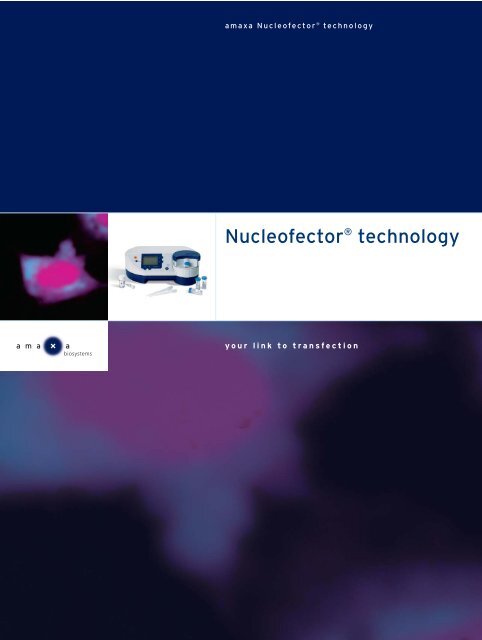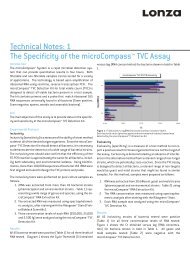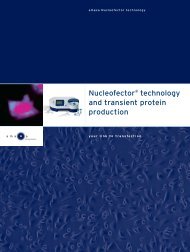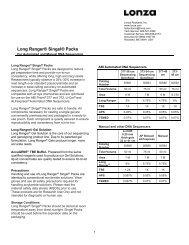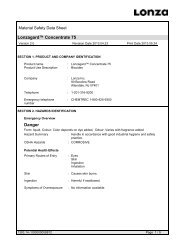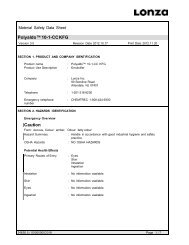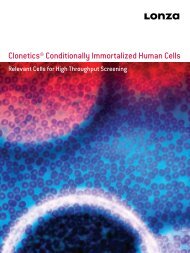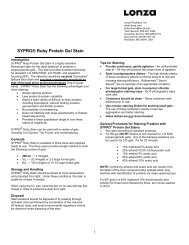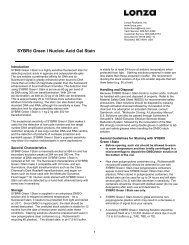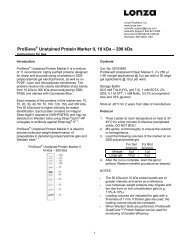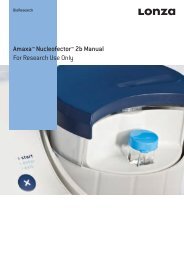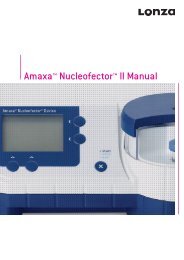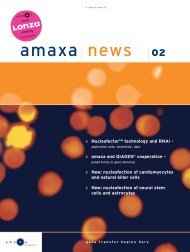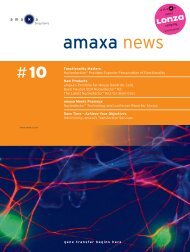amaxa Nucleofector technology flyer - Lonza AG
amaxa Nucleofector technology flyer - Lonza AG
amaxa Nucleofector technology flyer - Lonza AG
You also want an ePaper? Increase the reach of your titles
YUMPU automatically turns print PDFs into web optimized ePapers that Google loves.
<strong>amaxa</strong> xxxxxxxxxxxx <strong>Nucleofector</strong> research<br />
® <strong>technology</strong><br />
<strong>Nucleofector</strong> ® <strong>technology</strong><br />
your link to transfection
<strong>Nucleofector</strong> ® <strong>technology</strong><br />
DNA delivery straight into the<br />
nucleus<br />
Normal human dermal fibroblasts –<br />
neonatal were nucleofected with 2.5 μg<br />
TMR-labeled plasmid DNA encoding<br />
eGFP. After 2 hours, cells were fixed<br />
with 3.5% PFA and analyzed by confocal<br />
microscopy. TMR label is shown<br />
in (A), GFP fluorescence in (B), DAPI<br />
nuclear staining in (C) and a merge of<br />
all three fluorescent labels in (D).<br />
page 2 www.<strong>amaxa</strong>.com <strong>Nucleofector</strong> ® <strong>technology</strong><br />
The <strong>Nucleofector</strong> ® <strong>technology</strong><br />
is the only reliable non-viral transfection method for a wide<br />
range of difficult-to-transfect cell lines and primary cells.<br />
Established in leading labs<br />
The <strong>Nucleofector</strong> ® <strong>technology</strong> has become an established transfection<br />
<strong>technology</strong> in many labs worldwide. A growing number<br />
of publications illustrates the importance of the <strong>technology</strong> for<br />
day-to-day research in addressing issues of formerly difficultto-transfect<br />
cell lines and primary cells.<br />
One <strong>technology</strong> for cell lines and primary cells<br />
Using the <strong>Nucleofector</strong> <strong>technology</strong>, cell lines, as well as<br />
primary cells, can be reliably transfected. DNA delivery<br />
straight into the nucleus ensures transfection efficiencies of<br />
up to 90% in both, cell lines and primary cells.<br />
Use of many different substrates<br />
With the <strong>Nucleofector</strong> <strong>technology</strong> various nucleic acids<br />
can be easily transfected such as DNA, RNA or siRNA. Transfection<br />
parameters remain the same for DNA, RNA and siRNA<br />
so that no further optimization is required.<br />
Maintenance of functionality<br />
The nucleofection ® procedure has no influence on the cell<br />
functionality. Nucleofected cells show long-term survival in<br />
culture and can easily be differentiated or stimulated.<br />
A<br />
C<br />
B<br />
D
<strong>Nucleofector</strong> ® <strong>technology</strong><br />
new<br />
puC ori<br />
Kanamycin<br />
pmaxGFP<br />
(3486 bp)<br />
SV 40 pA<br />
PCMV<br />
max GFP<br />
Plasmid map of pmaxGFP<br />
Cells transfected with pmaxGFP can be easily analyzed for<br />
transfection efficiency by flow cytometry or fluorescent<br />
microscopy.<br />
Positive controls available<br />
page 3 www.<strong>amaxa</strong>.com <strong>amaxa</strong> – your link to transfection<br />
Intron<br />
The two components of the<br />
<strong>Nucleofector</strong> ® <strong>technology</strong><br />
The <strong>Nucleofector</strong> ® II Device<br />
The <strong>Nucleofector</strong> II Device delivers unique electrical parameters<br />
that are different from other commercially available electroporation<br />
instruments. Electrical settings are pre-programmed for<br />
each optimized cell type. The integrated chipcard reader allows<br />
quick program and software updates for future applications.<br />
> easy handling motor-driven carousel for automatic cuvette handling<br />
> high convenience large graphic display for easy day-to-day use<br />
> great flexibility software enables the filing of individual programs<br />
> future proof suitable to use together with the 96-well Shuttle<br />
The <strong>Nucleofector</strong> ® Kits<br />
The <strong>Nucleofector</strong> Kits contain <strong>amaxa</strong> specified cuvettes, pipettes,<br />
pmaxGFP, <strong>Nucleofector</strong> Solution and Supplement. Each<br />
solution and supplement is individually developed for every<br />
primary cell type. For cell lines, five different <strong>Nucleofector</strong><br />
Solutions, C, L, R, T and V, are available. All solutions provide a<br />
cell-friendly environment that ensure the highest transfection<br />
results and cell viability. <strong>Nucleofector</strong> Kits are only functional<br />
in combination with the <strong>Nucleofector</strong> Device.<br />
Introducing maxGFP<br />
All <strong>Nucleofector</strong> Kits contain a plasmid encoding maxGFP, a<br />
green fluorescent protein from the copepod Pontellina p.<br />
The new siRNA Test Kit offers the opportunity to easily establish<br />
siRNA in cell lines or adherent primary cells. The kit contains<br />
pmaxGFP and an siRNA duplex directed against maxGFP together<br />
with a detailed protocol. Gene silencing can thus be easily<br />
monitored by decrease of maxGFP expression.<br />
siRNA Test Kit Cat. No. VSC-1001
cell lines<br />
The ideal tool for<br />
transfection of cell lines<br />
The <strong>Nucleofector</strong> <strong>technology</strong> is the ideal tool for transfection of<br />
virtually any type of cell line, such as, commonly-used cell lines<br />
or difficult-to-transfect cell lines. High transfection efficiencies<br />
are combined with high cell viability and reproducibility of transfection<br />
results.<br />
> high efficiencies up to 90% gene transfer efficiency with high cell viability<br />
> ideal for siRNA up to 99% transfection efficieny with siRNA duplexes even<br />
in suspension cells<br />
> safe and easy procedure easy and convenient handling<br />
> fast experiments expression within hours - from transfection to analysis in<br />
Visit the <strong>amaxa</strong><br />
cell line database<br />
Enter your cell line<br />
of interest or view<br />
complete list<br />
Screen results<br />
one day<br />
page 4 www.<strong>amaxa</strong>.com <strong>Nucleofector</strong> ® <strong>technology</strong><br />
How to find your cell line of interest<br />
Cell type listed<br />
Click on cell name<br />
Your cell line of interest<br />
Cell type not listed<br />
Use Cell Line Optimization<br />
<strong>Nucleofector</strong> Kit or contact<br />
<strong>amaxa</strong>’s Scientific Support<br />
Use recommended<br />
for further advice.<br />
<strong>Nucleofector</strong> Kit in combination<br />
with the respective Optimized<br />
Protocol or use the settings<br />
optimized by other users.
cell lines<br />
d<br />
Optimization of virtually any cell line in just one experiment<br />
Difficult-to-transfect The advanced Cell Line Optimization <strong>Nucleofector</strong> Kit is<br />
cell lines an ideal tool for the transfection of your difficult-to-transfect<br />
cell line. It enables you to conveniently determine the optimal<br />
nucleofection parameters of your cell line of interest within one<br />
experiment.<br />
1 Solution L V<br />
program 1 A-020 A-020<br />
program 2 T- 020 T- 020<br />
program 3 T-030 T-030<br />
program 4 X-001 X-001<br />
program 5 X-005 X-005<br />
program 6 L- 0 2 9 L- 0 2 9<br />
program 7 D-023 D-023<br />
Step 1 The cell line of interest is transfected<br />
with the <strong>Nucleofector</strong> Solutions<br />
L and V in combination with seven<br />
different <strong>Nucleofector</strong> programs.<br />
Examples of <strong>amaxa</strong> optimized cell lines<br />
293 ATCC ® CRL-1573 84%<br />
293 (DSMZ) 57%<br />
32D ATCC ® CRL-11346 79%<br />
3T3-L1 (pre-ad) ATCC ® CL-173 73%<br />
A-10 ATCC ® CRL-1476 64%<br />
A20 ATCC ® TIB-208 74%<br />
A-431 ATCC ® CRL-1555 45%<br />
A549 ATCC ® CCL-185 72%<br />
<strong>AG</strong>S ATCC ® CRL-1739 73%<br />
BA/F3 (DSMZ) 88%<br />
BHK-21 ATCC ® CCL-10 85%<br />
BJ ATCC ® CRL-2522 52%<br />
C2C12 ATCC ® CRL-1772 82%<br />
C6 ATCC ® CCL-107 95%<br />
Caco-2 ATCC ® HTB-37 59%<br />
CCRF-CEM ATCC ® CCL-119 68%<br />
CHO-K1 (DSMZ) 84%<br />
CHO-K1 ATCC ® CCL-61 94%<br />
CHO-suspension (ECACC) 92%<br />
COS-1 ATCC ® CRL-1650 49%<br />
COS-7 (DSMZ) 85%<br />
DU 145 ATCC ® HTB-81 47%<br />
EL4 ATCC ® TIB-39 65%<br />
FDC-P1 ATCC ® CRL-12103 82%<br />
HaCaT (DKFZ) 43%<br />
HCT 116 ATCC ® CCL-247 78%<br />
For an updated cell list and to view customer derived data for approximately 300 additional cell types please go to<br />
www.<strong>amaxa</strong>.com/celldatabase.<br />
Step 2 The <strong>Nucleofector</strong> Solution and<br />
program which result in highest transfection<br />
efficiencies with lowest mortality<br />
are selected.<br />
HeLa ATCC ® CCL-2 70%<br />
HeLa (DSMZ) 57%<br />
HepG2 ATCC ® HB-8065 64%<br />
HL-60 ATCC ® CCL-240 50%<br />
HT-29 ATCC ® HTB-38 51%<br />
HT-1080 ATCC ® CCL-121 74%<br />
HuT 78 ATCC ® TIB-161 53%<br />
IMR-90 ATCC ® CCL-186 51%<br />
JURKAT ATCC ® TIB-152 54%<br />
JURKAT (DSMZ) 63%<br />
K562 ATCC ® CCL-243 89%<br />
K562 (DSMZ) 76%<br />
KG-1 ATCC ® CCL-246 70%<br />
LNCaP ATCC ® CRL-1740 70%<br />
MCF-7 ATCC ® HTB-22 71%<br />
MDA-MB-231 ATCC ® HTB-26 80%<br />
MDA-MB-453 ATCC ® HTB-131 54%<br />
MDA-MB-468 ATCC ® HTB-132 60%<br />
MDCK ATCC ® CCL-34 73%<br />
MDCK II (ECACC) 80%<br />
MOLT-4 ATCC ® CRL-1582 55%<br />
NALM-6 (DSMZ) 64%<br />
NB-4 (DSMZ) 71%<br />
NCI-H1299 ATCC ® CRL-5803 99%<br />
Neuro-2a ATCC ® CCL-131 76%<br />
NIH/3T3 ATCC ® CRL-1658 84%<br />
page 5 www.<strong>amaxa</strong>.com <strong>amaxa</strong> – your link to transfection<br />
2<br />
> > ><br />
3<br />
V Solution<br />
Step 3 A further fine tuning of the<br />
nucleofection conditions can be performed<br />
with the help of our Scientific<br />
Support Team.<br />
+<br />
> > ><br />
NIH-3T3 (DSMZ) 68%<br />
NRK ATCC ® CRL-6509 44%<br />
NS0 (ECACC) 83%<br />
P19 ATCC ® CRL-1825 85%<br />
PC-12 ATCC ® CRL-1721 34%<br />
PC-3 ATCC ® CRL-1435 81%<br />
PANC-1 ATCC ® CRL-1469 68%<br />
Raji ATCC ® CCL-86 58%<br />
Ramos ATCC ® CRL-1596 27%<br />
RAW 264.7 ATCC ® TIB-71 65%<br />
RBL-1 ATCC ® CRL-1378 84%<br />
S49 ATCC ® TIB-36 81%<br />
Saos-2 ATCC ® HTB-85 82%<br />
SH-SY5Y ATCC ® CRL-2266 82%<br />
SK-OV-3 ATCC ® HTB-77 89%<br />
SK-N-SH ATCC ® HTB-11 85%<br />
SW480 ATCC ® CCL-228 60%<br />
T-47D ATCC ® HTB-133 51%<br />
THP-1 ATCC ® TIB-202 67%<br />
U-2 OS ATCC ® HTB-96 98%<br />
U-937 ATCC ® CRL-1593.2 56%<br />
U-87 MG ATCC ® HTB-14 43%<br />
U266BI ATCC ® TIB-196 86%<br />
Vero ATCC ® CCL-81 79%<br />
WEHI-231 ATCC ® CRL-1702 77%
primary cells<br />
d<br />
Nucleofection of primary cells<br />
In the past, the lack of efficient and easy transfection methods<br />
for primary cells restricted experiments mainly to cell lines.<br />
However, the artifical nature of cell lines limits the significance<br />
of experimental results. Today, the isolation and culture of primary<br />
cells is well-established. With introduction of the unique<br />
<strong>Nucleofector</strong> <strong>technology</strong> the last obstacle, the efficient non-viral<br />
transfection of such cell types, was overcome in 2001. The<br />
<strong>technology</strong> is now a well-established method worldwide.<br />
Researchers are now able to address open questions of their<br />
specific research area in many primary cell types which reflect<br />
a much more relevant physiological system than any cell line<br />
could ever be.<br />
> high efficiencies up to 90% gene transfer efficiency with high cell viability<br />
> no optimization ready-to-use kits for a multitude of cell types<br />
> reproducible results Optimized Protocols for each cell type with details on cell<br />
isolation and culture<br />
> ideal for primary cells direct transport of nucleic acids into the nucleus thus<br />
Functional CD2 silencing in primary<br />
human T cells<br />
Primary human T cells were transfected<br />
with 1.4 μg siRNA targeted to<br />
CD2 using the Human T Cell <strong>Nucleofector</strong><br />
Kit. 44 hours post nucleofection,<br />
cells were stained with anti<br />
CD2-FITC antibody (A) or anti CD4-<br />
PE antibody (B) and analyzed by<br />
flow cytometry. Controls included<br />
nucleofection of 1.4 μg control siRNA<br />
and addition of CD2 siRNA without<br />
nucleofection.<br />
page 6 www.<strong>amaxa</strong>.com <strong>Nucleofector</strong> ® <strong>technology</strong><br />
enabling transfection even of non-dividing cells<br />
siRNA transfection in primary cells -<br />
up to 99% transfection efficiency<br />
The <strong>Nucleofector</strong> <strong>technology</strong> ensures efficient delivery of siRNA<br />
even in primary cells enabling strong knock-down effects. High<br />
cell viability of more than 85% is maintained even with higher<br />
amounts of siRNA.<br />
counts<br />
200<br />
160<br />
120<br />
80<br />
40<br />
0<br />
10 0<br />
A<br />
CD2-FITC<br />
10 1<br />
For further information about nucleofection of siRNA in primary cells and cell lines, go to www.<strong>amaxa</strong>.com/RNAi<br />
or contact our Scientific Support Team.<br />
10 2<br />
10 3<br />
10 4<br />
counts<br />
300<br />
240<br />
180<br />
120<br />
60<br />
0<br />
10 0<br />
CD4-PE<br />
CD2 siRNA control siRNA<br />
no siRNA + nucleofection<br />
B<br />
10 1<br />
10 2<br />
10 3<br />
10 4
primary cells<br />
d<br />
Transfection results you can trust<br />
Examples for primary cell Transfection efficiency*<br />
<strong>Nucleofector</strong> Kits<br />
Dendritic cells, human 49%<br />
cancer research HUVEC 90%<br />
MEF 43%<br />
etc.<br />
Cardiomyocytes, rat 35%<br />
cardiovascular research HMVEC-L 52%<br />
MSC, human 47%<br />
etc.<br />
Dermal fibroblasts, human 89%<br />
dermatology Keratinocytes, human 53%<br />
etc.<br />
B cells, human 36%<br />
immunology Macrophages, mouse 47%<br />
Macrophages, human 59%<br />
T cells, human 64%<br />
T cell, mouse 39%<br />
etc.<br />
Neurons, mouse 58%<br />
neurobiology Neurons, rat cortical 59%<br />
Neural stem cells, mouse 60%<br />
etc.<br />
Hepatocytes, mouse 54%<br />
gastroenterology Hepatocytes, rat 52%<br />
* Data show examples of average transfection efficiencies given as % positive viable cells. Cells were either transfected with a plasmid encoding maxGFP, eGFP<br />
or H-2K k , a mouse MHC class I molecule. Analysis was performed by either flow cytometry or fluorescence microscopy. Cell viability varies between 50-90%.<br />
Protect your cells from mycoplasma<br />
<strong>amaxa</strong> offers new antibiotic formulations specifically developed to protect cell lines or sensitive<br />
primary cells against mycoplasma, gram+ and gram- bacteria as well as fungi.<br />
Primocin for primary cells Cat. No. VZA-1021<br />
Normocin for cell lines Cat. No. VZA-1001<br />
Plasmocin for mycoplasma cure Cat. No. VZA-1012<br />
For more information about the new cell culture antibiotics, see www.<strong>amaxa</strong>.com/antibiotics.<br />
page 7 www.<strong>amaxa</strong>.com <strong>amaxa</strong> – your link to transfection
WKB-1001_01.2006<br />
d<br />
For an up-to-date<br />
overview or more<br />
detailed information<br />
about <strong>amaxa</strong> products,<br />
please see<br />
www.<strong>amaxa</strong>.com/<br />
productlist.<br />
Cat.No.<br />
AAD-1001 <strong>Nucleofector</strong> ® device<br />
VPG-1006 Astrocytes, mouse<br />
VPG-1007 Astrocytes, rat<br />
VPA-1001 B cells, human<br />
Ordering information<br />
<strong>Nucleofector</strong> ® Kits for primary cell types<br />
VPE-1002 Cardiomyocytes, rat neonatal<br />
VPA-1003 CD34+ cells, human<br />
VPF-1001 Chondrocytes, human<br />
VPA-1004 Dendritic cells, human<br />
VPD-1001 Dermal fibroblasts, human<br />
VPD-1006 Embryonic fibroblasts, mouse, Starter Kit<br />
VPD-1004 Embryonic fibroblasts, mouse, Kit I<br />
VPD-1005 Embryonic fibroblasts, mouse, Kit II<br />
VPH-1001 Embryonic stem cells, mouse<br />
VPB-1001 Endothelial cells, human coronary artery (HCAEC)<br />
VPB-1003 Endothelial cells, human microvascular (HMVEC-L)<br />
VPB-1002 Endothelial cells, human umbilical vein (HUVEC)<br />
VPK-1001 Epithelial cells, human coronary artery<br />
VPK-1002 Epithelial cells, human mammary<br />
VPK-1003 Epithelial cells, human prostate<br />
VPL-1002 Hepatocytes, mouse<br />
VPL-1003 Hepatocytes, rat<br />
VPD-1002 Keratinocytes, human<br />
VPA-1008 Macrophages, rat<br />
VPA-1009 Macrophages, mouse<br />
VPA-1007 Monocytes, human<br />
VPD-1003 Melanocytes, human epidermal neonatal (NHEM)<br />
VPE-1001 Mesenchymal stem cells, human<br />
VPA-1005 Natural killer cells, human (NK)<br />
VPG-1004 Neural stem cells, mouse<br />
VPG-1005 Neural stem cells, rat<br />
VPG-1002 Neurons, chicken<br />
VPG-1001 Neurons, mouse<br />
VPG-1003 Neurons, rat<br />
VPG-1009 Oligodendrocytes, rat<br />
VPC-1001 Smooth Muscle Cells, human aortic (AoSMC)<br />
VPA-1002 T cells, human<br />
VPA-1006 T cells, mouse<br />
Basic <strong>Nucleofector</strong> ® Kits<br />
VPI-1001 Mammalian endothelial cells<br />
VPI-1002 Mammalian fibroblasts<br />
VPI-1003 Mammalian neural cells<br />
VPI-1004 Mammalain smooth muscle cells<br />
VPI-1005 Mammalian epithelial cells<br />
<strong>Nucleofector</strong> ® Kits for cell lines<br />
VCO-1001 Cell Line Optimization <strong>Nucleofector</strong> ® Kit<br />
VCA-1004 Cell Line Kit C<br />
VCA-1005 Cell Line Kit L<br />
VCA-1001 Cell Line Kit R<br />
VCA-1002 Cell Line Kit T<br />
VCA-1003 Cell Line Kit V<br />
<strong>amaxa</strong>'s <strong>Nucleofector</strong> ® Process, <strong>Nucleofector</strong> ® Device and <strong>Nucleofector</strong> ® Solutions are covered by PCT Applications PCT/EP01/07348,<br />
PCT/DE02/01489, PCT/DE02/01483, and other pending patents, and domestic or foreign applications corresponding thereto.<br />
<strong>amaxa</strong>, <strong>Nucleofector</strong>, nucleofection, maxGFP and 96-well Shuttle are trademarks of <strong>amaxa</strong> GmbH.<br />
The CMV promoter is covered under U.S. Patents 5,168,062 and 5,385,839 and its use is permitted for research purposes only. Any other use of<br />
the CMV promoter requires a license from the University of Iowa Research Foundation, 214 Technology Innovation Center, Iowa City, IA 52242.<br />
ATCC ® and the ATCC Catalog Marks are trademarks of ATCC used under License.<br />
<strong>amaxa</strong> GmbH, Europe/World <strong>amaxa</strong> Inc., USA<br />
Scientific Support Scientific Support<br />
+49 (0)221-99199-400 (240) 632-9110<br />
scientific-support@<strong>amaxa</strong>.com www.<strong>amaxa</strong>.com scientific-support.US@<strong>amaxa</strong>.com


